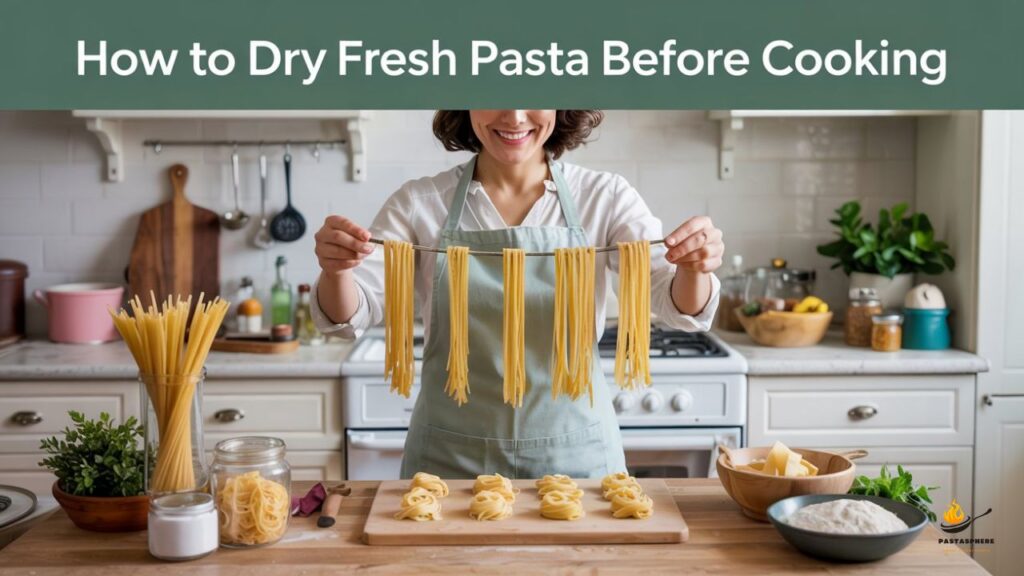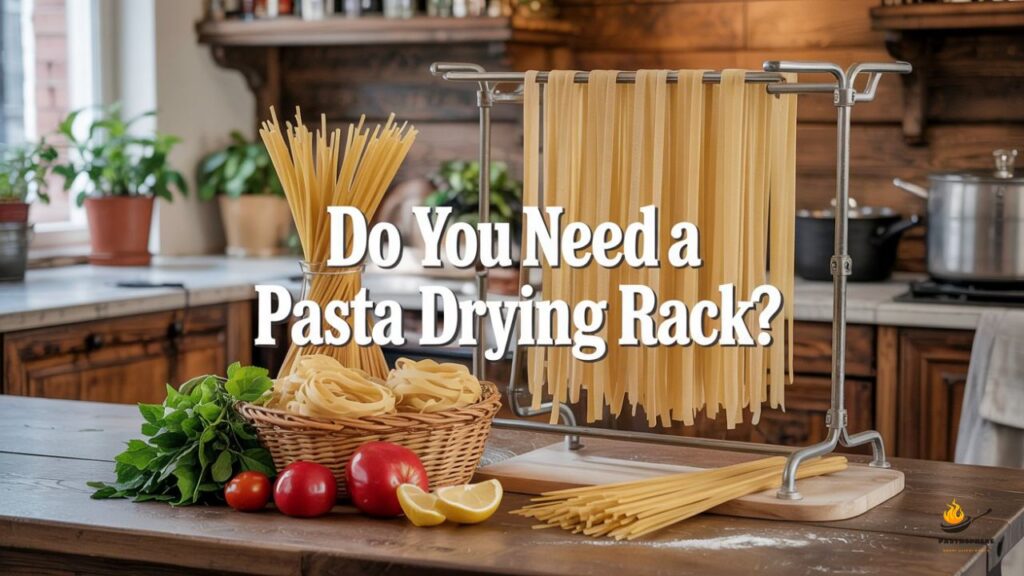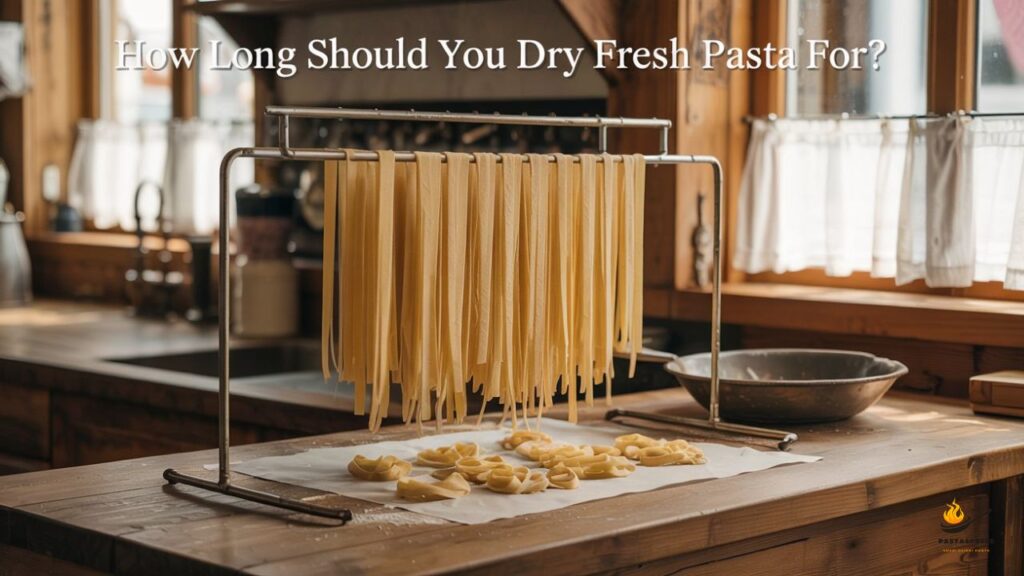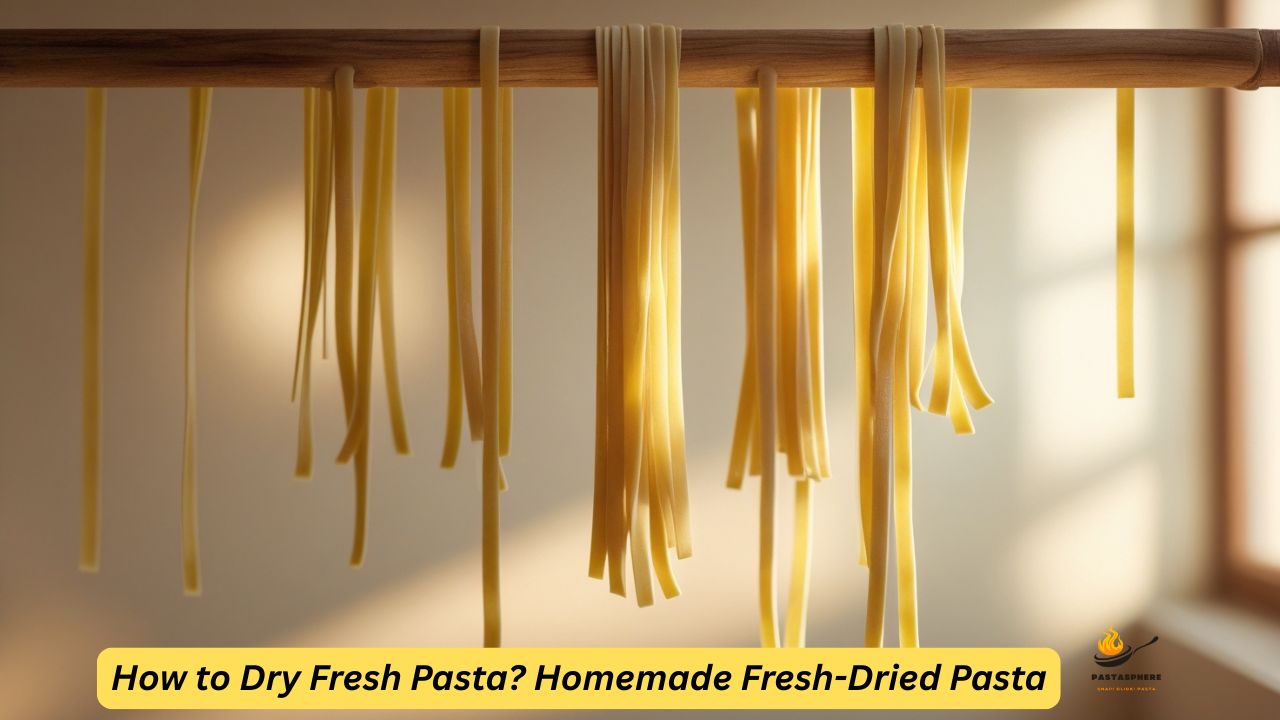Table of Contents
ToggleMaking fresh pasta at home is a rewarding experience, offering unmatched flavour, freshness, and texture compared to store-bought dried pasta. But if you’re planning to store it for later, you might be wondering—how to dry fresh pasta properly?
The key is to spread pasta in a single layer on a floured surface or hang it to air dry for 15 minutes to 24 hours, or use a dehydrator for faster drying.
In this article, you’ll learn how to dry fresh pasta with best pasta drying methods, factors that affect drying time, and how to store dried pasta to maintain its freshness.
How to Dry Fresh Pasta Before Cutting?
Sometimes, drying before cutting helps with handling. Place your dough on a flat, floured surface and leave to dry for 15 minutes before cutting it into the desired shape. This step prevents the dough from becoming too sticky and makes cutting easier.
How to Dry Fresh Pasta Before Cooking?

If you plan on cooking your pasta within a few hours, you don’t need to dry it completely. Just let it sit on a floured surface for about 30 minutes. This helps the dough firm up without becoming brittle, making it easier to handle and cook.
Different Drying Methods for Pasta
Now, let’s talk about the different ways you can dry fresh pasta:
- Oven drying: Low heat (95°F or 35°C) can be used for faster drying.
- Air drying: The most traditional and natural method.
- Using a dehydrator: Speeds up drying but requires careful monitoring.
Do you know what's the exact method of cooking and reheating frozen pasta? If not. Don't worry! Checkout this detailed article at PastaSphere.
How to Cook Frozen Pasta? Freezing & Reheating Guide
Do You Need a Pasta Drying Rack?

You might be wondering if a drying rack is necessary. While a pasta maker can help, a drying rack isn’t always needed. When I first started making fresh pasta, I didn’t have fancy equipment, but I found great alternatives right at home:
- Hanging strands on a broom handle
- Draping them over the back of a chair
- Placing them on a floured surface
Instead of a drying rack, you can opt for these alternative methods. If choosing the latter, be sure to cover the pasta with a tea towel to prevent it from drying too quickly. Lightly dusting the pasta with flour will also help prevent sticking.
How Long Should You Dry Fresh Pasta For?

The drying time depends entirely on various factors, including room temperature, humidity, and the thickness of the dough. Here’s a general guideline:
- If you plan to cook it the same day: Leave to dry for about 15 minutes
- For short-term storage (1-2 days): Allow 30 minutes to 12 hours
- For long-term storage: Place in an uncovered, dry area for 12 to 24 hours
Timing is key when drying fresh pasta. If the dough starts to crack, it means it has been drying for too long.
Factors Affecting Pasta Drying Time
Before we dive into the different drying methods, it’s important to understand what affects the drying time of fresh pasta. Several factors affect the drying time of fresh pasta, including:
- Humidity levels: Higher humidity means a longer drying time.
- Room temperature: Warmer temperatures allow for faster drying.
- Pasta thickness: Thicker pasta takes longer to dry.
- Air circulation: Better airflow reduces drying time.
- Floured surface: Placing pasta on a floured surface prevents sticking and aids in drying.
How to Dry Fresh Pasta for Future Use
Now that we know the basics, let’s go step by step on how to properly dry fresh pasta if you want to store fresh pasta for later use, follow these steps:
- Cut your shapes: Whether making tagliatelle, fettuccine, or angel hair pasta, ensure they are properly cut.
- Spread in a single layer: Lay the pasta on a baking tray or countertop.
- Sprinkle with flour: This prevents the pasta from sticking.
- Leave to dry: Allow it to dry for 12 to 24 hours, turning at regular intervals.
- Check the dryness: If it snaps when bent, it is ready.
- Store in airtight containers: This prevents moisture from affecting its shelf life.
Does Fresh Pasta Really Needs to Dry First?
Drying ensures that the freshly-made pasta maintains its flavour, texture, and structure when cooked. If fresh pasta is cooked straight away without drying, it can become stickier, clump together, or even fall apart. Drying also keeps its shape and allows for even cooking.
When I first started pasta making, I didn’t resist the temptation to cook it immediately. I assumed that I could cook it straight away, but I quickly learned that drying is necessary to prevent unpleasant textures in the final dish. Even worse, pasta that hasn’t been dried properly can break apart in the water.
Common Mistakes When Drying Pasta
Avoid these errors when drying fresh pasta:
- Not allowing enough air circulation: Can lead to mold.
- Over-drying: Can make pasta brittle and difficult to cook.
- Drying in high humidity: Affects the process and can lead to spoilage.
- Skipping flour dusting: Causes pasta to stick together.
Drying Homemade Pasta for Storage
If you’re planning on storing pasta long-term, ensure it’s dried properly:
- Egg pasta: Needs careful drying as it contains more moisture.
- Stuffed pasta shapes: Like tortellini, must be dried thoroughly to seal properly and avoid moisture causing spoilage.
- Delicate pasta: Such as spaghetti, should be dried in nests for a fantastic presentation.
Best Storage Practices for Dried Pasta
Once your pasta is fully dried, you need to store it correctly:
- Use airtight containers: Prevents moisture from getting in.
- Store in a cool, dark place: Away from heat and humidity.
- Label with the drying date: Ensures freshness tracking.
How Do You Store Long Noodles Like Tagliatelle?

Long noodles like tagliatelle can be dried and stored in nests to prevent them from sticking together.
- To do this, gently lift small sections of the noodles, lightly twist and twirl them into loose coils, and place them on a floured surface or tray.
- Make sure they are not too tightly wound, as they need airflow to dry properly.
- Once dried, store them in an airtight container at room temperature, away from moisture and heat.
FAQ About How to Dry Fresh Pasta
How Long Does Dry Pasta Last?
Properly dried pasta can last up to two years if stored in an airtight container.
Does Dry Pasta Go Bad?
If stored properly, dry pasta does not spoil quickly. However, exposure to moisture can cause mold growth.
Can You Use a Dehydrator to Dry Pasta?
Yes, a dehydrator can speed up drying, but you must monitor it carefully to avoid over-drying.
What Is Pasta Bianca?
Pasta Bianca is egg-free pasta, which dries faster than egg pasta due to its lower moisture content.
Can I Freeze Fresh Pasta Instead of Drying It?
Yes, you can place it in an airtight container and freeze it for later use. It should be consumed within 24 hours before being frozen for the best texture.
Can I Dry Pasta in a Warm Environment?
Warm environments help speed up drying, but avoid hot days and high humidity as these can cause drying too quickly, leading to cracks.
Conclusion
Drying pasta is a skill that improves with experience. If you are grappling with sticky dough, remember that timing is key. Whether using drying racks or household items, the key is ensuring the pasta is dried properly. With practice, you’ll become an expert at pasta making, and your homemade pasta will be ready for any pasta recipes you create!













